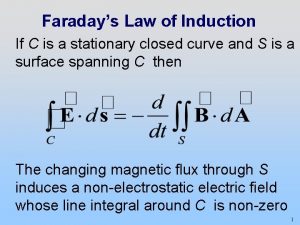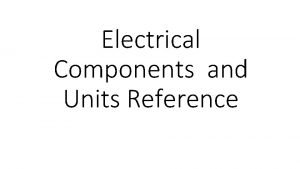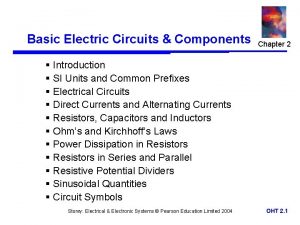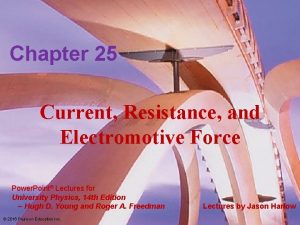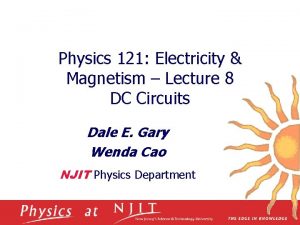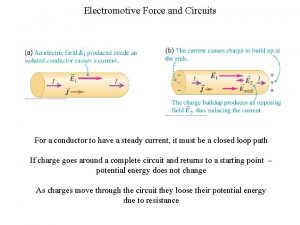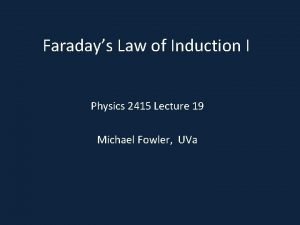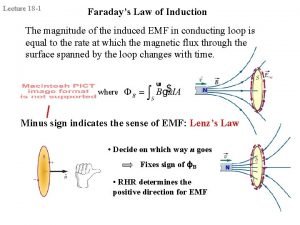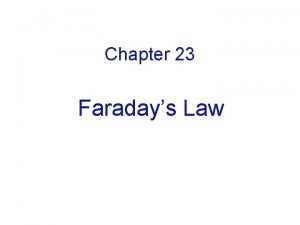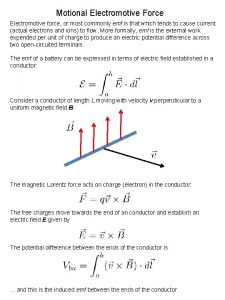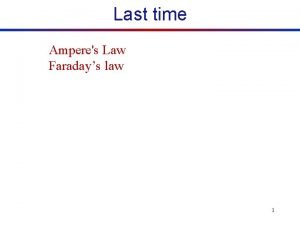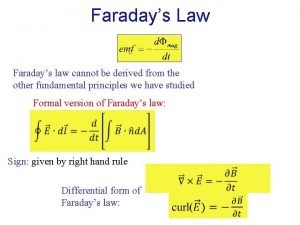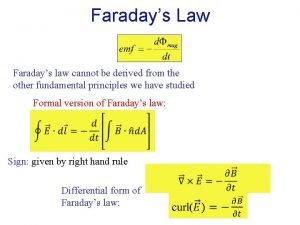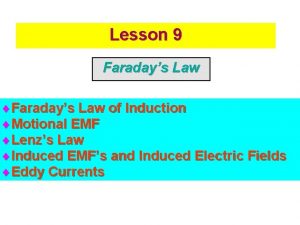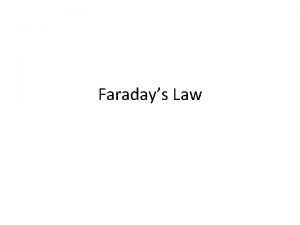Faradays Law Electromotive Force EMF Suppose we have











- Slides: 11

Faraday’s Law Electromotive Force (EMF) + • Suppose we have some source of force on charges that transport them • Suppose it is capable of doing work W on each charge • It will keep transporting them until the work required is as big as the work it can do – q • The voltage difference at this point is the electromotive force (EMF) • Denoted E

Motional EMF • Suppose you have the following circuit in the presence of a B-field W • Charges inside the cylinder • Now let cylinder move • Moving charges inside conductor feel force L • Force transport charges – it is capable of doing work • This force is like a battery - it produces EMF • v is the rate of change of the width W • We can relate this to the change in magnetic flux Right hand rule for Faraday’s Law: EMF you get is right-handed compared to direction you calculated the flux v B

Power and Motional EMF • Resistor feels a voltage – current flows • Where does the power come from? • Current is in a magnetic field v R L • To get it to move, you must oppose this force • You are doing work The power dissipated in the resistor matches the mechanical power you must put in to move the rod B F

Sample Problem • We figure out the voltage around a loop using the right-hand rule • Multiply by N if there are N loops • Let’s calculate flux coming out of the screen • This gives us EMF counter-clockwise + A loop of wire is in the shape of a square of side 10 cm and has 120 turns of wire. It is moved steadily to somewhere there is no magnetic field, so B goes from 100 m. T to 0 in 0. 0100 s, what is the EMF produced, and which wire is positive? –

Electric Fields from Faraday • We can generate electromotive force – EMF – by moving the loop in and out of magnetic field • Can we generate it by moving the magnet? Faraday’s Law works whether the wire is moving or the B-field is changing* • How can there be an EMF in the wire in this case? • Charges aren’t moving, so it can’t be magnetic fields • Electric fields must be produced by the changing B-field! • The EMF is caused by an electric field that points around the loop *Ultimately, this led to Einstein’s Theory of Relativity Magnet

Lenz’s Law • As the wire shrunk, the magnetic flux decreased • But the wire acquired a current, which tried to increase it The induced current in a loop is in the direction that opposes the change in magnetic flux through the area enclosed by the loop • Move loop to the right • Current flows to maintain B-field • Current dies away • Move loop to the left • Current flows to kill B-field • Current dies away

How to Make an AC Generator • Have a background source of magnetic fields, like permanent magnets • Add a loop of wire, attached to an axle that can be rotated • Add “commutators” that connect the rotating loop to outside wires • Rotate the loop at angular frequency • Magnetic flux changes with time • This produces EMF • To improve it, make the loop repeat many (N) times A

Sample Problem A rectangular loop of wire 20 cm by 20 cm with 50 turns is rotated rapidly in a magnetic field B, so that the loop makes 60 full rotations a second. At t = 0 the loop is perpendicular to B. (a) What is the EMF generated by the loop, in terms of B at time t? (b) What B-field do we need to get a maximum voltage of 170 V? • The angle is changing constantly with time • After 1/60 second, it must have gone in one full circle • The flux is given by: • The EMF is given by: loop of wire

Comments on Generators • The EMF generated is sinusoidal in nature (with simple designs) • This is called alternating current - it is simple to produce • This is actually how power is generated • Generators extremely similar to motors – often you can use a single one for both • Turn the axle – power is generated • Feed power in – the axle turns • Regenerative braking for electric or hybrid cars Generators: • When current does not flow, there is little resistance to turning the axle • When current does flow, magnetic fields produce forces that resist turning the axle Motors: • When power is demanded, they require a lot of electric current • When power is not needed, little power keeps them going

Motors and Power • Long ago I said magnetic fields do no work – but clearly, motors do work • Suppose we have a loop of wire feeling a torque in a motor • Power is torque times angular velocity • The magnetic flux is changing – this causes an EMF • Electric power in is • It is the incoming current that is doing the work

Ground Fault Circuit Interruptors • Fuses/circuit breakers don’t keep you from getting electrocuted • But GFI’s (or GFCI’s) do GFCI • Under normal use, the current on the live wire matches the current on the neutral wire • Ampere’s Law tells you there is no B-field around the orange donut shape • Now, imagine you touch the live wire – current path changes (for the worse) • There is magnetic field around the donut • Changing magnetic field means EMF in blue wire • Current flows in blue wire • Magnetic field produced by solenoid • Switch is magnetically turned off
 Electromotive force unit
Electromotive force unit Electromotive force unit
Electromotive force unit Electromotive force unit
Electromotive force unit Which produces an electromotive force (e.m.f.)
Which produces an electromotive force (e.m.f.) Sources of electromotive force
Sources of electromotive force Electromotive force ppt
Electromotive force ppt What is electromotive force
What is electromotive force Electromotive force and circuits
Electromotive force and circuits The current i varies directly as the electromotive force
The current i varies directly as the electromotive force Young and freedman
Young and freedman Paramagnetic
Paramagnetic Faraday's law of electromagnetic induction
Faraday's law of electromagnetic induction
